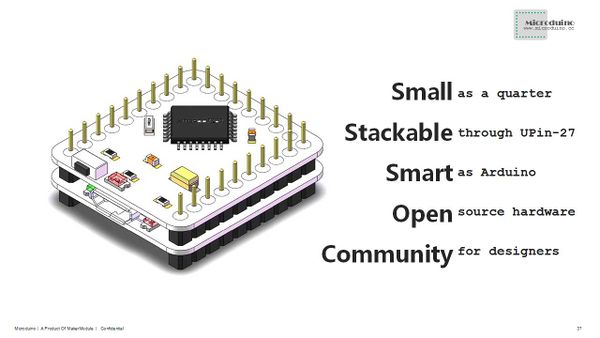Microduino-Core
|
Microduino-Core is one of core modules of Microduino series, Microduino-Core is an open source hardware and Arduino Uno compatible. It is an 8-bit microcontroller development board, based on Atmel ATmega328P/ATmega168PA series. Comparing to Arduino Uno, Microduino-Core is featured by:
Microduino-Core and Microduino-FT232R modules -- MCU and USB2TTL parts. it means once designers uploaded program into Microduino-Core, Microduino-FT232R will be not necessary anymore, designers could have many Microduino-Core/Core+ modules with only one Microduino-FT232R. The board size becomes very small as only 25.4mm X 27.94mm (1.0inch X 1.1inch), like a quarter.
Microduino, all Microduino modules and sensors can be easily stacked and extended, it is delivered ready to plug in.
cost of design prototype, remarkable improves usability and flexibility of Arduino-compatible boards, as well as user experience.
IDE, Processing on Microduino for idea realization, prototype development and low volume production. Microduino uses optiboot for bootloader, it takes less Flash than Arduino default engine and optimizes program uploading. Currently, there are 4 different configurations for Microduino-Core modules:
Different configurations in frequency and supply voltage:
module is by 5.0V voltage.
regarding mobile equipments or designs, a 8M with 3.3V module is suggested for low power and battery supply purposes.
| |||||||||||||||||||||||||||||||||||||||||||
目录Core vs Core+
applications which require large SRAM/EEPROM/Flash and more I/O ports.
standard module interface of Microduino series. The main difference between them is MCU chip: - Core module uses ATmega328P/ATmega168PA, as same as Arduino Uno; -Core+ module uses ATmega644PA/ATmega1284P, its performance is similar to Arduino Mega2560.
supply different size of digital I/O and hardware serial ports, and there are 10 more digital I/O and 1 more hardware serial ports in Core+. Designers can select specific module regarding different application requirements on function, performance and power.
them. | |||||||||||||||||||||||||||||||||||||||||||
Features
Microduino modules and sensors can be easily stacked and extended through it
| |||||||||||||||||||||||||||||||||||||||||||
Specifications
value, a rising or falling edge, or a change in value. See the attachInterrupt() function for details.
library.
download】 | |||||||||||||||||||||||||||||||||||||||||||
Documents
| |||||||||||||||||||||||||||||||||||||||||||
Development
from 【Arduino IDE official】 and install it in your disk. (if you already have it, just skip this step). Please check Arduino IDE details from 【Reference】 and 【Workshop】.
【download】, and unzip is to {Your Arduino Install Driectory}/hardware directory.
recommended to use Microduino-FT232R module.
themselves, designers can leaverage Arduino Uno or another burned Microduino-Core/Core+ to make a new one.
Arduino]]】.
selected during burning.
flash. | |||||||||||||||||||||||||||||||||||||||||||
Applications
| |||||||||||||||||||||||||||||||||||||||||||
Buy
| |||||||||||||||||||||||||||||||||||||||||||
History
| |||||||||||||||||||||||||||||||||||||||||||
Pictures
|

